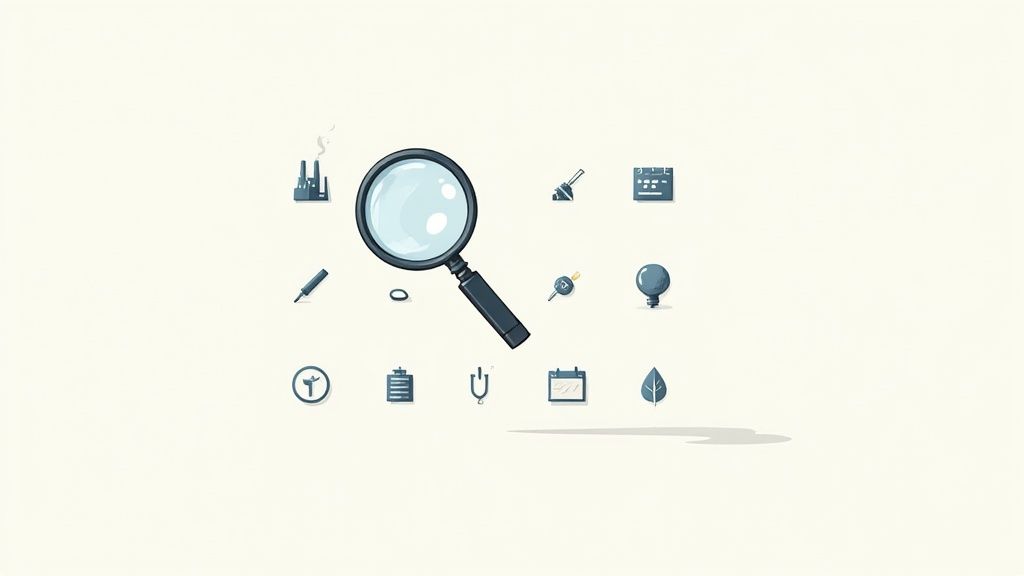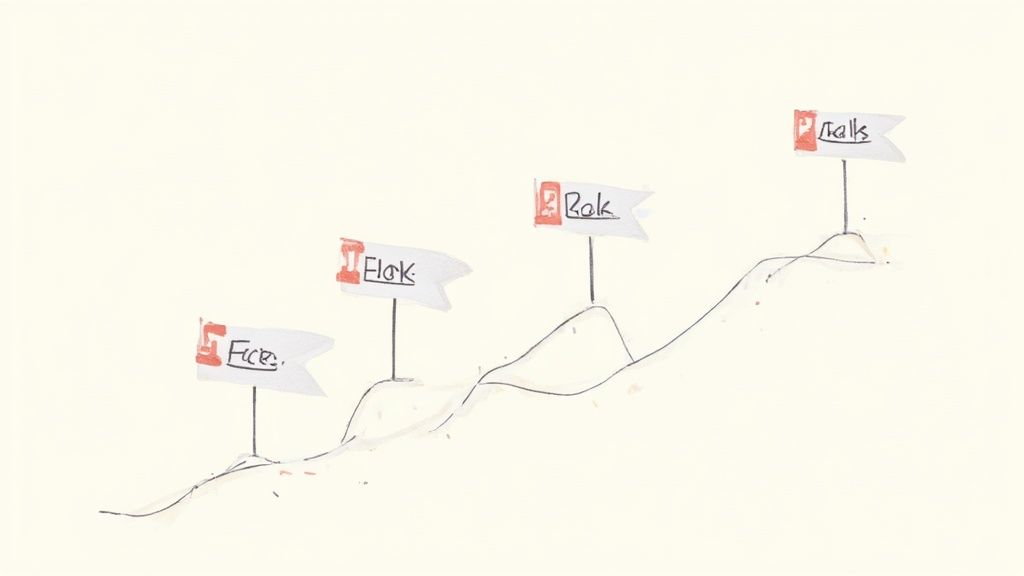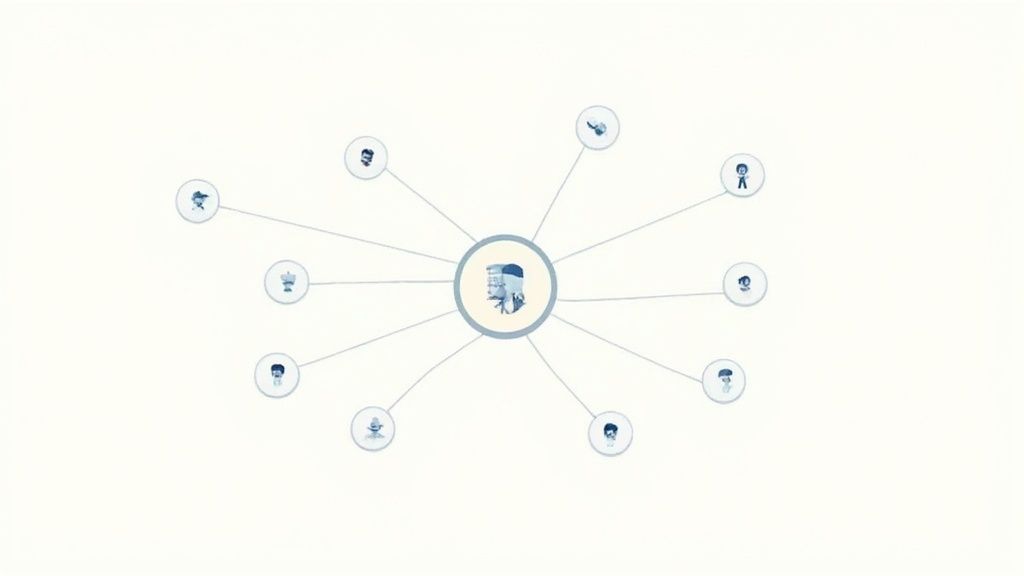Ready for a Fresh Start? Here’s How to Make It Happen
Considering a career change? Feeling overwhelmed? This listicle provides eight essential career change tips to guide you toward a fulfilling and successful transition. Whether you're a solopreneur, aspiring creator, career pivoter, coach, or simply seeking more purpose, these actionable steps will empower you to navigate your career change journey effectively. Learn how to assess your skills, research new industries, develop a strategic learning plan, build your network, and craft a compelling career change narrative. Plus, discover practical advice for gaining experience and navigating the financial aspects of your transition. Start creating the career you deserve today.
1. Conduct a Thorough Self-Assessment
Embarking on a career change can feel like stepping into the unknown. It's a journey of self-discovery and reinvention, and like any successful journey, it requires a solid roadmap. That's why the first, and arguably most crucial, step in changing careers is conducting a thorough self-assessment. This process empowers you to take stock of your existing skills, passions, values, and aspirations, laying the foundation for a fulfilling and aligned career move. It helps you answer the fundamental question: "Where do I want to go, and how do I get there?" This deep dive into your inner landscape provides clarity and direction, preventing hasty decisions that could lead to further career dissatisfaction.

A comprehensive self-assessment involves exploring your strengths and weaknesses, identifying your core values, and pinpointing your true interests. This might involve reflecting on past experiences, considering what truly motivates you, and visualizing your ideal future. It's about uncovering your transferable skills – those valuable assets you've developed that can bridge the gap between your current career and your desired one. Perhaps you've honed excellent communication skills in your current role, or maybe you're a natural problem-solver. These skills are gold dust in the career transition process. This self-assessment isn't just about identifying what you can do; it's also about understanding what you want to do. What kind of work environment energizes you? What impact do you want to make on the world? Clarifying these priorities is key to finding a career that truly resonates with your soul.
Think of Sara Blakely, the founder of Spanx. Before revolutionizing the shapewear industry, she assessed her skills in sales and problem-solving, recognizing how these strengths could be applied to create a product that met a real need. Similarly, Jeff Bezos famously used a "regret minimization framework" to assess his career change from finance to the then-nascent world of e-commerce. By envisioning his future self and minimizing potential regrets, he made a bold leap that transformed the retail landscape.
Tips for Conducting a Thorough Self-Assessment:
- Create a comprehensive skills inventory: List your hard skills (technical abilities), soft skills (interpersonal skills), and transferable skills.
- Seek external perspectives: Ask trusted colleagues, mentors, or friends for honest feedback on your strengths and blind spots.
- Consider professional guidance: A career counselor can provide objective insights and tailored recommendations based on your unique profile.
- Utilize assessment tools: Explore online resources like CliftonStrengths or 16Personalities as starting points for self-discovery.
- Journal your engagement: Track when you feel most energized and fulfilled in your current work to identify activities that align with your passions.
Pros:
- Provides clarity and direction for your career transition.
- Reduces the risk of choosing an unsuitable career path.
- Unveils unexpected career possibilities that align with your attributes.
- Enhances self-awareness, leading to better career decisions.
Cons:
- Can be time-consuming and emotionally challenging.
- May require professional support for objective assessment.
- May reveal difficult truths about your skills or market realities.
This first step in the career change process is foundational for solopreneurs, aspiring creators, career pivoters, coaches/consultants, and purpose-driven professionals alike. This self-assessment deserves its place at the top of this list because it empowers you to take control of your career trajectory and build a future aligned with your authentic self. Inspired by works like Richard Bolles' "What Color Is Your Parachute?" and informed by frameworks like John Holland's RIASEC model and Gallup's CliftonStrengths assessment, self-assessment provides the compass you need to navigate the exciting, sometimes daunting, terrain of career change.
2. Research Target Industries and Roles
One of the most crucial career change tips is to thoroughly research potential industries and roles before taking the leap. This isn't just about browsing job boards; it's a deep dive into understanding the landscape of your desired career path. This involves examining industry trends, dissecting job requirements, understanding compensation expectations, and getting a feel for the work environment and potential growth opportunities. By taking this crucial step, you ensure your new direction aligns not only with your passions but also with market realities, setting yourself up for long-term success. This focused research empowers you to make informed decisions, avoiding potential pitfalls and maximizing your chances of finding a fulfilling and sustainable career.

This research process involves several key features, including labor market analysis, industry forecasting, informational interviews with professionals already in the field, and a careful examination of educational requirements and certifications. It also means understanding salary ranges and compensation structures, and exploring company cultures and work environments. For solopreneurs, this translates to researching niche markets and competitive landscapes. Aspiring creators can use this research to identify content gaps and audience needs. Career pivoters benefit immensely by gaining clarity on potential paths and required skills. Even established coaches and consultants can leverage this research to refine their target audience and service offerings.
Think of Elon Musk's extensive research into the space industry before founding SpaceX, or Sallie Krawcheck's investigation of financial industry gaps before launching Ellevest. These are prime examples of how thorough research can lead to disruptive innovation and personal fulfillment. These individuals identified a need, researched the market, and positioned themselves for success. This level of due diligence is essential for any career change, big or small.
Why is this so important for a career change? This step deserves its place on the list because it prevents unrealistic expectations, identifies viable entry points, and helps you target specific organizations that support career transitions. It can even reveal hidden job markets and emerging opportunities you might otherwise miss. Imagine uncovering a niche market perfectly suited to your skills, or discovering a rising industry with immense growth potential! This research empowers you to make informed choices and pursue opportunities aligned with your long-term goals.
Pros:
- Prevents unrealistic expectations about new careers
- Identifies viable entry points for career changers
- Helps target specific organizations that support career transitions
- Reveals hidden job markets and emerging opportunities
Cons:
- Information can become outdated quickly in fast-changing industries
- Time-intensive process requiring consistent effort
- May reveal discouraging barriers to entry for certain fields
Actionable Tips for Effective Research:
- Follow industry leaders and publications on social media: Stay updated on trends and gain valuable insights.
- Attend industry conferences and networking events as an observer: Immerse yourself in the field and connect with professionals.
- Set up Google Alerts for target companies and industry trends: Receive real-time updates and stay ahead of the curve.
- Use LinkedIn to identify and analyze career paths of people in desired roles: Learn from the journeys of others and gain valuable career insights.
- Schedule at least 5-10 informational interviews with professionals in your target field: Gain firsthand knowledge and build your network.
- Join professional associations in your target industry as an affiliate member: Access resources, connect with peers, and stay informed.
By following these career change tips and dedicating the necessary time and effort to research, you’ll be well-equipped to navigate the complexities of a career transition and embark on a path that aligns with your passions and aspirations. Resources like the Bureau of Labor Statistics Occupational Outlook Handbook, LinkedIn's annual workplace and hiring trend reports, and career pivot expert Jenny Blake's 'Pivot Method' can further assist in your research journey.
3. Develop a Strategic Learning Plan
Dreaming of a career change but feeling overwhelmed by the sheer scale of it? Don't worry, you're not alone. One of the most effective career change tips is to develop a strategic learning plan. This structured approach empowers you to acquire the necessary skills and knowledge to confidently transition into your target field. It's like charting a course to your dream destination, ensuring you arrive equipped and prepared for success. A strategic learning plan meticulously identifies the skill gaps between your current capabilities and the requirements of your desired career, then maps out efficient learning pathways to bridge those gaps.

This plan isn't a one-size-fits-all solution; it's deeply personalized. It considers your individual learning style, whether you thrive in structured classrooms or prefer self-directed exploration. Your plan will include a realistic timeline with milestones, incorporating a mix of formal education (like university courses or bootcamps), informal learning opportunities (such as online courses, workshops, or self-study), and practical application. Critically, it also addresses budget considerations for educational investments, helping you make smart financial decisions as you reskill.
Features of a Powerful Strategic Learning Plan:
- Gap Analysis: A clear identification of the skills you currently possess and the skills you need to acquire.
- Customized Learning Pathways: Tailored to your learning style and preferences.
- Timeline with Milestones: Sets achievable goals and tracks your progress, keeping you motivated.
- Blended Learning Opportunities: Combines formal and informal learning for a well-rounded skillset.
- Budget Considerations: Helps you manage the financial investment involved in reskilling.
Why a Strategic Learning Plan Deserves its Place on This List:
This approach takes the daunting task of reskilling and breaks it down into manageable, achievable steps. It enables you to continue earning income while gaining new skills, minimizing financial disruption. Moreover, a documented learning plan provides tangible evidence of your commitment to your new field, impressing potential employers. Perhaps most importantly, the progressive achievement of milestones builds your confidence and fuels your momentum throughout the transition process.
Pros:
- Makes reskilling manageable and less overwhelming.
- Allows for continued income during the transition.
- Demonstrates commitment to the new field.
- Builds confidence through progressive achievements.
Cons:
- Can require a significant financial investment.
- May extend the career transition timeline.
- Requires balancing learning with current work obligations.
Inspiring Examples:
- Ryan Carson successfully transitioned from web design to tech education by systematically learning programming skills before founding Treehouse.
- Statistician Linda Burtch created a structured learning plan to pivot into data science, ultimately founding Burtch Works, a prominent analytics recruiting firm.
- IBM's New Collar initiative has helped thousands transition to tech careers through strategic skill development programs.
Actionable Tips for Creating Your Own Plan:
- Start Small: Dip your toes in with free courses to gauge your genuine interest before investing heavily.
- Prioritize Transferable Skills: Focus on skills that bridge the gap between your previous experience and your new target field.
- Build a Portfolio: Create learning projects that produce tangible portfolio pieces to showcase your newfound abilities.
- Find Your Tribe: Join study groups or find accountability partners to stay motivated and supported.
- Schedule Dedicated Learning Time: Even just 30 minutes daily can make a significant difference.
- Seek Mentorship: Connect with mentors who can provide valuable insights and guide you towards efficient learning paths in your chosen field.
Inspiration and Resources:
Consider exploring resources like Coursera and Udacity's nanodegree programs, Tim Ferriss's accelerated learning approaches, Josh Kaufman's "The First 20 Hours" rapid skill acquisition method, and LinkedIn Learning's guided learning paths for further guidance and inspiration.
Whether you’re a solopreneur seeking to differentiate yourself, a career pivoter starting fresh, or a purpose-driven professional searching for more meaningful work, a strategic learning plan is the crucial roadmap that will empower you to navigate your career change journey with confidence and purpose.
4. Build a Transition Network
One of the most powerful career change tips you can implement is building a robust transition network. This involves strategically cultivating relationships with professionals in your target field. It's about more than just collecting business cards; it's about forging genuine connections that can provide insider knowledge, open doors to unadvertised opportunities, offer mentorship, and provide much-needed emotional support during a potentially challenging transition. This strategy shifts your focus from applying to countless online job postings to proactively engaging with the people who are already thriving in the field you aspire to join.

This approach deserves a prominent place on any list of career change tips because it addresses a fundamental truth: careers are often built, not just found. The "hidden job market," comprising unadvertised positions and opportunities arising from personal connections, is often inaccessible to those relying solely on traditional job search methods. A strong network unlocks this hidden market.
This networking strategy involves both digital and in-person approaches. You'll want to connect with individuals at all career stages in your desired industry, from entry-level to senior leadership. Finding mentors and sponsors—those who can advocate for you within the field—is a crucial component. Remember, consistent nurturing of these relationships is key; it's about giving value and building authentic connections, not transactional interactions. Think long-term growth, not short-term gains.
Consider the success stories: Whitney Wolfe Herd, formerly in a legal career, leveraged her network to transition into tech and ultimately founded Bumble. Similarly, Dorie Clark strategically built her network while pivoting from journalism to marketing consulting, a journey she documented in her book "Stand Out." These examples, along with LinkedIn's statistic that 85% of jobs are filled through networking, underscore the power of this approach.
Pros:
- Access to the "hidden job market" of unadvertised opportunities
- Opportunities for informational interviews and job shadowing
- Realistic perspectives on the day-to-day realities of your target field
- Enhanced social proof and credibility within the new industry
Cons:
- Can be challenging for introverts or those new to networking
- Requires a significant time investment with potentially delayed returns
- May involve rejection or non-responsiveness from busy professionals
Actionable Tips:
- Attend industry conferences and actively engage in breakout sessions.
- Join relevant professional associations and volunteer for committees.
- Create a targeted list of 50-100 potential connections in your desired field.
- Develop a concise and compelling elevator pitch about your career transition story.
- Schedule regular coffee chats or virtual meetings with new connections.
- Offer help and resources to your network before asking for assistance.
- Use LinkedIn's advanced search to find alumni connections in target companies.
When and Why to Use This Approach:
Building a transition network is particularly crucial for career changers, solopreneurs establishing service businesses, aspiring creators seeking their niche, and coaches/consultants looking to attract the right clients. It's especially relevant for purpose-driven professionals seeking more meaningful work, as connecting with like-minded individuals can provide invaluable insights and support. This method allows you to tap into the collective wisdom and experience of those already succeeding in your desired field, offering a fast track to understanding the nuances of the industry and discovering opportunities you might otherwise miss. Embrace the power of connection and watch your career aspirations flourish.
5. Craft Your Career Change Narrative
Making a career change can feel like navigating uncharted territory. One of the most powerful tools you can wield on this journey is a compelling career change narrative. This is more than just a polished resume or a well-rehearsed elevator pitch; it's the story of you—your past experiences, your present motivations, and your future aspirations, all woven together into a cohesive and inspiring message. Crafting a strong narrative is crucial among career change tips, as it provides the compass and confidence you need to successfully navigate your transition.
This approach works by reframing your past experiences, not as disparate chapters, but as stepping stones leading you to where you are meant to be. It's about identifying the "thread" that connects your seemingly unrelated roles and highlighting the transferable skills you've gained along the way. Instead of focusing on what you're leaving behind, you emphasize what you're bringing to the table. This empowers you to transform what might feel like a career discontinuity into a unique selling proposition.
Think about Vera Wang, who transitioned from a career in figure skating and fashion editing to become a renowned wedding dress designer at age 40. Or Sara Blakely, who leveraged her experience in door-to-door fax machine sales to found the billion-dollar shapewear company, Spanx. Even David Chang's journey from teaching to culinary innovation with Momofuku speaks volumes about the power of a well-crafted career change narrative. These individuals didn't just change careers; they reinvented themselves by connecting their past experiences to their future passions in a compelling and relatable way.
Why is crafting a career change narrative so vital among career change tips?
For solopreneurs building service businesses, a compelling narrative helps differentiate you from the competition. Aspiring creators can use it to define their unique positioning and attract a loyal following. Career pivoters gain a sense of direction and purpose, transforming uncertainty into a powerful story of transformation. Coaches and consultants can leverage their narrative to attract ideal clients, while purpose-driven professionals can finally articulate the meaning they seek in their work.
Features and Benefits of a Strong Career Change Narrative:
- Reframes past experience: Highlights transferable skills, demonstrating your value in a new context.
- Explains motivation: Presents your career change in positive, forward-looking terms, showcasing your proactive nature.
- Addresses concerns: Proactively answers potential employer questions about your shift in career trajectory.
- Demonstrates commitment: Shows thorough research and genuine enthusiasm for your new field.
- Tailored messaging: Adapts your story for different audiences (employers, networks, family).
Pros:
- Overcomes employer skepticism about career changers.
- Creates a memorable personal brand.
- Builds self-confidence through clarified purpose.
- Transforms potential liability into a unique selling proposition.
Cons:
- Requires nuance to avoid appearing unfocused or uncommitted.
- May need frequent refinement through feedback.
- Must be authentic to be convincing.
Actionable Tips for Crafting Your Narrative:
- Identify the Thread: What common themes or skills connect your past to your future aspirations?
- Practice Makes Perfect: Rehearse your narrative until it flows naturally and authentically.
- Seek Feedback: Test your story on people in your target industry and refine it based on their input.
- Vary the Length: Prepare different versions of your narrative (30 seconds, 2 minutes, 5 minutes) for various situations.
- Focus on Solutions: Emphasize the problems you can solve rather than what you want to gain.
- Use Specific Examples: Illustrate your skills with concrete examples from your previous work experience.
- Address Potential Objections: Anticipate and address concerns about your career change proactively.
By embracing these career change tips and investing the time to craft a compelling narrative, you'll not only stand out from the crowd but also empower yourself to make a successful and fulfilling transition into your next chapter.
6. Gain Practical Experience Through Side Projects
One of the most effective career change tips is to gain practical experience before taking the leap. This bridges the gap between your current career and your dream career, minimizing risk and maximizing your chances of success. Building experience through side projects empowers you to test the waters, develop crucial skills, and build a compelling portfolio that speaks volumes to potential employers. This approach is particularly powerful for solopreneurs, aspiring creators, career pivoters, coaches/consultants, and purpose-driven professionals seeking more fulfilling work.
This strategy revolves around dedicating time outside your current commitments to projects related to your desired field. It’s about turning your passion into action, transforming abstract aspirations into concrete achievements. Think of it as building a bridge to your dream career, one brick of experience at a time.
How it Works:
Instead of abruptly quitting your job and hoping for the best, you strategically carve out time for side projects, volunteer work, freelancing, or even part-time roles in your target industry. This allows you to:
- Create Evidence of Capabilities: Show, don't just tell. Side projects offer tangible proof of your skills and dedication.
- Build a Portfolio: Develop a collection of work samples that demonstrate your abilities in your target area. This is invaluable for showcasing your talents to prospective employers or clients.
- Test the Waters: Experience the realities of the field firsthand, confirming your interest and passion before committing fully.
- Develop Industry-Specific Knowledge: Gain fluency in the language, tools, and trends of your chosen industry.
- Network and Build Relationships: Connect with potential employers, clients, mentors, and peers, expanding your professional circle.
Examples of Success:
Consider the inspiring journeys of individuals who used side projects to launch successful career changes:
- Ava DuVernay: While working as a publicist, DuVernay honed her filmmaking skills through side projects, ultimately becoming an award-winning director.
- Alexis Ohanian: Ohanian co-founded Reddit as a side project while maintaining other work, eventually transitioning fully into entrepreneurship.
- Joy Mangano: Mangano developed her innovative household products while working as an airline reservations manager, demonstrating that passion projects can flourish alongside existing commitments.
Actionable Tips for Implementing Side Projects:
- Structure is Key: Treat your side projects like mini-businesses. Define clear deliverables, set deadlines, and track your progress.
- Volunteer Strategically: Identify nonprofit organizations that need the skills you want to develop. This offers valuable experience and expands your network.
- Embrace Challenges: Participate in hackathons or innovation challenges in your target industry to test your skills and gain exposure.
- Document Your Journey: Keep a detailed record of your learning process, challenges overcome, and outcomes achieved. This becomes invaluable portfolio material.
- Seek Feedback: Share your side work with professionals in the field and solicit constructive criticism. This accelerates your learning and refines your approach.
- Start Small, Scale Up: Begin with manageable commitments that can grow as your interest and confidence solidify. Microvolunteering offers a fantastic entry point.
Pros and Cons:
Pros:
- Reduced Financial Risk: Maintain financial security while exploring new career paths.
- Addresses the 'Experience Paradox': Overcomes the challenge of needing experience to get a job, but needing a job to get experience.
- Compelling Interview Material: Provides concrete examples to discuss during interviews, showcasing your initiative and passion.
- Potential Income Generation: Some side projects may generate income during the transition period.
Cons:
- Time Management is Crucial: Balancing side projects with existing commitments requires discipline and effective time management.
- Temporary Work-Life Imbalance: Be prepared for a potentially demanding period as you juggle multiple responsibilities.
- Progress Can Be Slow: Building experience takes time and effort. Be patient and celebrate small victories along the way.
Why This Deserves a Spot on the List:
Gaining practical experience through side projects is a crucial career change tip because it empowers you to take control of your career trajectory. It addresses the common fear of the unknown by providing a safe and structured way to explore new possibilities, build essential skills, and ultimately increase your chances of landing your dream job. This approach aligns perfectly with the needs of today’s career changers, offering a powerful pathway to professional fulfillment and success. It is popularized by concepts like Chris Guillebeau's "Side Hustle," the rise of freelance platforms like Upwork and Fiverr, and Daniel Pink's research on portfolio careers. This proactive approach minimizes risk and maximizes your chances of achieving a successful and fulfilling career transition.
7. Prepare Financially for the Transition
Switching careers is an exciting leap towards a more fulfilling professional life. But before you take that leap, make sure you have a strong financial safety net beneath you. Preparing financially for a career transition isn't just practical; it's empowering. It gives you the freedom to pursue your dreams strategically, without the cloud of financial stress hanging over your head. This is why financial planning is a crucial career change tip, and why it deserves its place on this list.
A comprehensive financial strategy is your bedrock during this period of change. It's about more than just having some money saved; it’s about proactively managing your finances to accommodate the potential shifts in income, new expenses, and unexpected hurdles that can arise during a career transition. This preparation allows you to make clear-headed, strategic decisions rather than being forced into choices driven by panic or desperation.
How it Works:
Financial planning for a career change addresses several key areas:
- Emergency Fund Development: Aim to build an emergency fund that covers at least 6-12 months of living expenses. This cushion provides crucial breathing room during periods of reduced income or unemployment. Think of it as your runway, allowing you to soar into your new career without crashing down.
- Budget Restructuring: Anticipate potential changes in income and adjust your budget accordingly. Identify areas where you can reduce spending and create a realistic budget specifically for the transition period.
- Education and Training Costs: Factor in any costs associated with acquiring new skills or certifications. Explore options like employer tuition assistance before leaving your current job or research scholarships and grants.
- Healthcare and Benefits: Research health insurance options carefully to avoid gaps in coverage during your transition. Understand the implications for benefits like retirement contributions and life insurance.
- Debt Management: Develop a strategy to manage existing debt during the transition. This might involve refinancing, consolidation, or prioritizing payments.
- Tax Implications: Research potential tax deductions for job search and education expenses. Understand how your career change might impact your tax bracket.
Successful Implementations:
- The Prepared Planner: JP Morgan's 2021 study revealed that career changers with at least six months of expenses saved were 65% more likely to report successful transitions. This underscores the power of a solid financial foundation.
- The Frugal Founder: Brandon Stanton, the creator of Humans of New York, lived frugally off his savings while developing his project from a side hustle to a full-fledged career. His financial discipline allowed him to dedicate his time and energy to his passion.
- The Multi-Hyphenate Chef: Samin Nosrat, the celebrated chef and author of Salt Fat Acid Heat, worked multiple jobs while honing her cooking skills before her career breakthrough. Her resourcefulness and financial planning enabled her to pursue her culinary dreams.
Actionable Tips for You:
- Build that Emergency Fund: Start today. Even small contributions add up over time. Aim for 6-12 months of expenses.
- Create a Transition Budget: Don't just guess. Create a detailed budget specifically for the transition period, anticipating potential income changes.
- Explore Healthcare Options: Don't wait until the last minute. Research health insurance options before leaving your current employment.
- Consider a Phased Approach: Could you work part-time in your new field while maintaining your current job? This can provide a smoother financial transition.
- Maximize Employer Benefits: Explore tuition assistance or professional development programs offered by your current employer before you leave.
- Research Tax Breaks: Look into tax deductions available for job search and education expenses. Knowledge is power (and savings!).
- Embrace Geographic Flexibility: Could relocating to a lower-cost area ease the financial burden during your transition?
Pros:
- Empowered Decision-Making: Reduces the pressure to accept the first available opportunity, allowing you to pursue the right fit.
- Resilience in the Face of Challenges: Prevents career change abandonment due to financial stress.
- Strategic Clarity: Enables well-thought-out decisions rather than panic-driven choices.
- Psychological Safety: Creates a sense of security and calm during uncertain times.
Cons:
- Delayed Gratification: May delay your transition timeline as you build your financial foundation.
- Lifestyle Adjustments: Requires careful budgeting and potential sacrifices.
- Financial Reality Check: Involves confronting your current financial situation, which can be uncomfortable.
Inspired by the financial wisdom of experts like Suze Orman and Vicki Robin, and drawing principles from the FIRE (Financial Independence, Retire Early) movement, taking control of your finances is the first step towards a successful and fulfilling career change. It's an investment in your future, and one that will pay dividends in peace of mind and the freedom to pursue your true calling.
8. Embrace Resilience and Adaptive Planning
Career change is a journey, not a destination, and rarely does it unfold exactly as envisioned. That's why embracing resilience and adaptive planning is crucial for not just surviving, but thriving during this transformative period. This approach is your secret weapon for navigating the inevitable bumps in the road, turning setbacks into stepping stones, and ultimately reaching your career goals. It's especially important for solopreneurs, aspiring creators, career pivoters, coaches/consultants, and purpose-driven professionals who are often forging their own paths.
What is it and how does it work?
Resilience and adaptive planning is about cultivating a growth mindset (popularized by Carol Dweck) and embracing change as an opportunity for learning. It's about acknowledging that rejection and setbacks are not failures, but valuable feedback. This approach requires building the psychological fortitude to persevere (think Angela Duckworth's work on grit) and maintaining flexibility in how you achieve your goals. Instead of rigidly adhering to Plan A, you’ll develop multiple pathways (Plan B, C, and even D!) and adjust your course as needed. This requires iterative career planning with regular reassessments, similar to the way Herminia Ibarra describes career transitions and identity change.
Why this deserves a spot on the list:
This tip deserves its place on this list because it addresses the often overlooked emotional aspect of career change. It equips you with the inner strength and adaptability needed to weather the storm and emerge stronger on the other side. Without resilience, even the most meticulously crafted career plan can crumble under the weight of the first major obstacle.
Features and Benefits:
- Iterative planning and reassessment: Regularly review your plan and adjust based on new information and experiences.
- Psychological preparedness: Develop coping mechanisms for rejection and setbacks, viewing them as learning opportunities.
- Multiple pathways: Create contingency plans and explore alternative routes to your desired outcome.
- Strong support system: Cultivate a network of mentors, peers, and advisors for guidance and encouragement.
- Stress management and self-care: Prioritize your well-being through practices like meditation, journaling, or exercise.
- Celebrating small wins: Acknowledge and appreciate your progress along the way to maintain motivation.
Pros:
- Prevents giving up after initial setbacks.
- Maintains momentum through challenging periods.
- Opens you up to unexpected opportunities.
- Builds valuable adaptability skills for future career navigation.
Cons:
- Can be emotionally challenging during extended transitions.
- Requires balancing persistence with pragmatic assessment.
- Sometimes involves acknowledging when original plans need significant revision.
Examples:
Think of J.K. Rowling's persistence through 12 rejections before Harry Potter was published. Or Arianna Huffington's pivot from publishing rejection to digital media innovation. Even Howard Schultz faced initial investor rejection before his vision for Starbucks became a reality. These are all testaments to the power of resilience and adaptive planning.
Actionable Tips for Career Change:
- Create formal contingency plans: "What if…?" scenarios help you anticipate and prepare for potential challenges.
- Establish a personal board of advisors: Seek guidance and perspective from trusted mentors and peers.
- Set process goals (actions you control): Focus on the steps you can take daily, rather than solely on outcomes.
- Maintain a rejection journal: Track lessons learned from setbacks to inform future decisions.
- Schedule regular strategic reassessments: Review your transition plan and make adjustments as needed.
- Build daily resilience practices: Incorporate activities like meditation, journaling, or exercise to manage stress.
- Connect with others making similar transitions: Build a support network for mutual encouragement and shared learning. Remember Brené Brown's work on the power of vulnerability and connection in building resilience.
By embracing resilience and adaptive planning, you’ll not only navigate the complexities of career change more effectively, but you'll also develop essential skills that will serve you well throughout your entire career journey. You are not defined by setbacks, but by how you respond to them. Embrace the challenge, adapt to the changes, and watch your career aspirations flourish.
8 Key Career Change Tips Comparison
| Tip Title | Implementation Complexity 🔄 | Resource Requirements ⚡ | Expected Outcomes 📊 | Ideal Use Cases 💡 | Key Advantages ⭐ |
|---|---|---|---|---|---|
| Conduct a Thorough Self-Assessment | Medium – requires time and reflection | Low to Medium – may need tools or counselor | High clarity on skills, values, and career direction | Early career changers seeking direction and self-awareness | Prevents hasty decisions; identifies transferable skills |
| Research Target Industries and Roles | Medium to High – involves extensive research | Medium – time, interviews, and data access | Realistic understanding of industry demands and trends | Career changers targeting specific industries | Reveals hidden opportunities; prevents unrealistic expectations |
| Develop a Strategic Learning Plan | High – requires structured planning and commitment | Medium to High – courses, certifications, money | Skill gaps addressed; credentials earned; increased confidence | Those needing new skills or formal qualifications | Manages reskilling efficiently; builds portfolio |
| Build a Transition Network | Medium to High – ongoing relationship building | Low to Medium – time investment, possible event costs | Access to job leads, insider info, mentorship | Career changers needing industry connections | Unlocks hidden job market; gains social proof |
| Craft Your Career Change Narrative | Low to Medium – writing and practicing story | Low – time and feedback | Strong personal brand; improves employer perceptions | Anyone needing to explain career change convincingly | Overcomes skepticism; builds confidence and clarity |
| Gain Practical Experience Through Side Projects | Medium to High – managing projects alongside current job | Low to Medium – time, possibly some costs | Hands-on experience; portfolio for resumes; tested interest | Career changers wanting risk-reduction and practical proof | Reduces financial risk; solves 'experience paradox' |
| Prepare Financially for the Transition | Medium – requires financial planning and discipline | Medium – savings, budgeting tools | Financial security; reduces stress; supports decision-making | Career changers facing income gaps or retraining costs | Enables strategic, anxiety-reduced transitions |
| Embrace Resilience and Adaptive Planning | Medium – mindset and process-oriented | Low – mostly time and emotional effort | Sustained momentum; flexibility to pivot if needed | All career changers, especially those facing uncertainty | Builds adaptability; turns setbacks into learning |
Your Next Chapter Starts Now
Changing careers can feel daunting, but by implementing these eight career change tips, you'll be well-prepared to navigate the transition successfully. From conducting a thorough self-assessment to building a resilient mindset, each step empowers you to take control of your professional future. Remember the key takeaways: understanding your values, researching potential career paths, developing new skills, and networking strategically. These are the foundations of a successful career change. Mastering these approaches unlocks the door to a career aligned with your passions and purpose. This journey allows you to leverage your existing experience while building new skills to create a fulfilling and impactful career. If you're seeking flexible, high-impact roles that leverage your executive skills, explore the growing landscape of fractional executive jobs – a field that offers exciting opportunities for experienced professionals seeking new challenges. These roles, as highlighted in Top Fractional Executive Jobs in 2025 | Flexible High-Impact Roles from Shiny, can be a great stepping stone in your career transition journey.
Embrace the process, stay adaptable, and build a future that reflects the best version of you. Now is the time to write your next chapter—a fulfilling career that aligns with your true purpose and potential. Ready to take the next step and craft a compelling career narrative that sets you apart? Henri Den helps you articulate your unique story, define your brand, and connect with opportunities that resonate with your values. Start building your dream career today.





